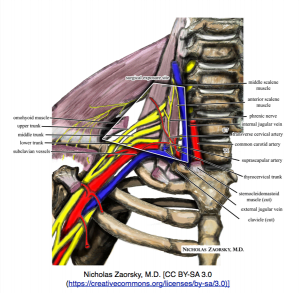This video shows a sequence of techniques from my Side Lying Massage DVD. This sequence may be helpful for clients with Thoracic Outlet Syndrome.
Scalenus Posterior
Have your client facing toward the floor.
Scalenus Medius
Have your client facing straight ahead.
Scalenus Anterior
Have your client facing toward the ceiling.
Sit behind your client so that your thigh is supporting their back. Bring your client’s shoulder forward and also upwards (anterior and superior) toward their ear, then hook your fingers into the space superior to the medial end of the clavicle right next to the sternum. Press inferiorly with your fingertips then pull your fingers laterally out toward the notch at the acromioclavicular joint while you pull your client’s shoulder in an inferior and posterior direction with your other hand.
Tightness in the scalene muscles may compress nerves of the brachial plexus, causing referred pain, tingling, and numbness into the arm and hand.
A variation on the scalene technique can be found here.
Pectoralis Stretch Stroke
Sit on the table behind your client so that their back is supported by your knee and thigh. Hold your client’s arm by the elbow and bring it back posteriorly while stroking the upper fibers of the pectoralis major with your fingertips, going from the sternum to the humerus.
On women work high up on the pectoralis major so that you are not on breast tissue.
Work into the distal fibers of the pectoralis major with the heel of your hand while stretching your client’s arm back and overhead.
Pectoralis Minor
Sit on the table behind your client so that their back is supported by your knee and thigh. Hold your client’s arm by the elbow then slide your fingers on the chest wall underneath the front wall of the axilla (pectoralis major) until you contact the fibers of the pectoralis minor. Work up the fibers of the pectoralis minor while bringing your client’s arm overhead. Go gently as this can be tender.
This can be done slowly with your client’s breathing. Have your client inhale deeply, then press into the pectoralis minor and bring their arm overhead as they exhale.
Subscapularis
Sit on the table behind your client so that their back is supported by your knee and thigh. Hold your client’s arm by the elbow then wrap your fingers around the back wall of the axilla and the scapula, so that they are on the subscapularis. Press into the subscapularis while bringing the arm overhead and into external rotation. Go gently as this can be tender.

- Pain, tingling or numbness down the medial side of the arm going to the 4th & 5th fingers (C8 dermatome).
- The arm goes to sleep at night or when held overhead.
- The radial pulse diminishes when the arm is held overhead
